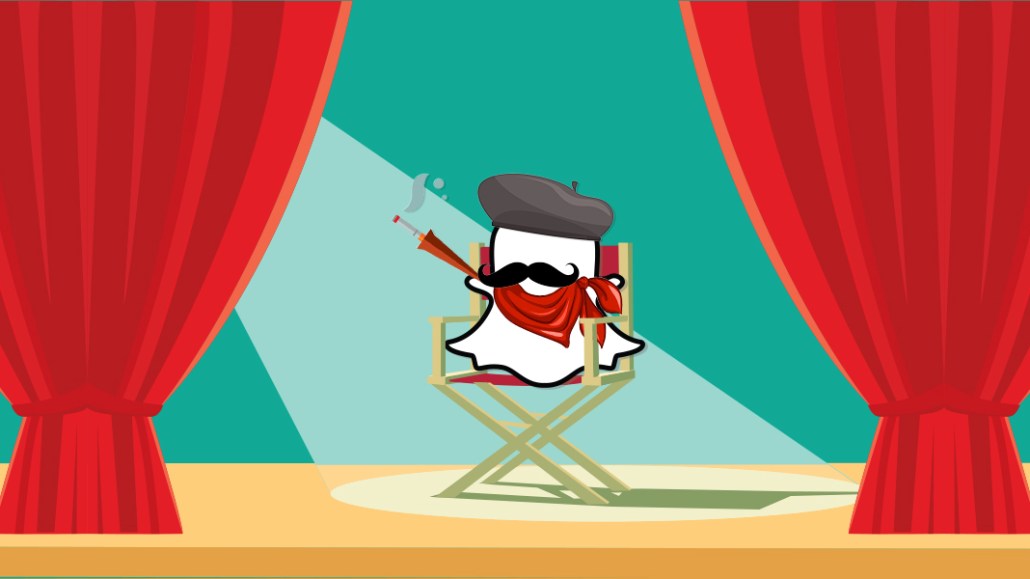Save 50% on a 3-month Digiday+ membership. Ends Dec 5.
Snapchat takes a flexible approach to how advertising is sold in its shows

Snapchat has chosen to take a flexible approach to how Snapchat shows make money. In some cases, that means partners taking the lead in sales; in others, Snapchat does.
Snap’s content and advertising deals with major media companies including NBCUniversal (an investor in Snap), Turner and Viacom give the show producers the first rights to sell sponsorships and ad slots within their programs. The media companies get a favorable cut on ads they sell, typically more than the 50 percent of revenue Snap splits with Discover publishers on ads sold by Snap, sources said. For advertisers that want to sponsor individual shows from these major media companies, it means working with that specific company on a campaign. Prices for individual show sponsorships can still cost several hundred thousands of dollars or more, according to two senior ad executives.
Today, the CPMs on Snapchat video inventory is in the $6 to $10 range, according to ad buyers. If the buy is made through a Snapchat shows partner, the CPMs net out to $15 to $20.
Some of Snap’s content partners are also creating new packages for advertisers that want to buy more than one show. For instance, NBCUniversal, which produces everything from NBC News’ twice-daily “Stay Tuned” to E!’s thrice-weekly “The Rundown,” is already out in the market with a bundle that allows marketers to advertise against all of its Snapchat shows, a source said.
The story is slightly different with digital publishers and studios making shows for Snapchat. For instance, Uproxx, which will soon launch a new series called “Brawler” on Snapchat, said Snap is taking the lead on monetizing the show. Snap brought a Wendy’s series sponsorship for Barstool Sports’ “Fifth Year” last fall, according to Barstool Sports CEO Erika Nardini.
Snap is planning to double the number of shows it offers in 2018 to roughly 80, which will include working with both traditional media companies and digital publishers on the content.
While it can be pricey, sponsoring an entire show and creating specific assets that are contextually relevant to that program will lead to better engagement and ad performance, said Brent Poer, president and executive creative director for brand and content at Zenith.
Ad position: web_incontent_pos1
“We have assets and if we want to be on Snapchat, we can go buy audiences run of site,” said Poer. “But I tend to want to go and cherry-pick and work with specific partners and shows — even if it’s the harder way.”
Increasingly, though, Snap itself is moving away from selling individual series sponsorships, according to the two senior ad executives. One ad exec said in a recent meeting with Snap, the company was nudging him toward a broader Snap Ads video buy across Snapchat, which would include placements within Snapchat shows targeted to the audiences the advertiser wanted to reach.
“Snap hasn’t been pitching specific shows to us, but it’s possible to buy their individual show sponsorships through the media partners,” said the exec. “Snap’s pitching in-stream inventory as a channel similar to the way that Google sells its preferred inventory. They talk about their inventory being consistent, high-quality and evenly reaching their audience.”
However, Snap is also beginning to put new types of shows on the table. The company is looking to stretch into long-form original video, though long is a relative term. As part of its new push into scripted programming, Snap is talking to advertisers about its plans to premiere episodic series and one-off programs that would run roughly six minutes long, said an agency executive familiar with the matter. It’s likely that this content is being produced by the joint venture that Snap formed with NBCUniversal last year to develop original scripted programming; NBCU has been mentioned as being involved in the longer content, according to the agency exec.
One senior ad exec, from an agency that frequently runs campaigns on Snapchat, said he expects the Snap Ads product to go almost entirely programmatic in the near future. More than 90 percent of Snap Ads were bought programmatically in the fourth quarter, and the number of advertisers spending in the auction doubled quarter over quarter, Snap said. This, combined with the recent departure of Snap’s head of sales Jeff Lucas — a longtime TV and media sales exec — only further reinforces the notion that Snap is emphasizing programmatic video buying above all else.
Ad position: web_incontent_pos2
This won’t necessarily rule out the ability for advertisers to sponsor individual media companies and shows on the platform. The agency exec pointed to Twitter’s in-stream video ad product, which allows marketers to pick individual publishers, as a model that Snap is likely to employ as its programmatic business grows.
“Like Twitter, they are facing pressure to be profitable and streamline their sales force and operations teams,” said an ad buyer. “Going programmatic might sacrifice some CPM, but if they have demand, which it feels like they do based on their earnings and the fact that so many clients work with them, they could go fully programmatic. They already have self-service for geofilters.”
Tim Peterson contributed reporting.
More in Marketing

Ulta, Best Buy and Adidas dominate AI holiday shopping mentions
The brands that are seeing the biggest boost from this shift in consumer behavior are some of the biggest retailers.

U.K. retailer Boots leads brand efforts to invest in ad creative’s data layer
For media dollars to make an impact, brands need ad creative that actually hits. More CMOs are investing in pre- and post-flight measurement.

‘AI is permeating everything we do’: How Guitar Center developed 2 AI tools this year
This summer, the company launched a chatbot called Rig Advisor to help customers find the right instruments and products.
Ad position: web_bfu



